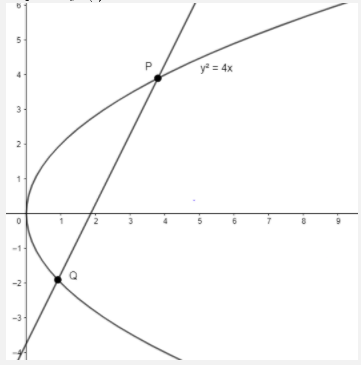Question
Question: The locus of a point which divides a chord of slope 2 of the parabola \[{{y}^{2}}=4x\] internally in...
The locus of a point which divides a chord of slope 2 of the parabola y2=4x internally in the ratio 1:2 is
(a) (y+94)2=94(x−92)
(b) (y−98)2=94(x−92)
(c) (y−98)2=94(x+92)
(d) (y+98)2=94(x+92)
Solution
Hint: To find the locus of point which divides a chord of given slope of the parabola internally in the ratio 1:2, write the equation of chord joining any two points of the parabola and then find the point which divides these two points on the parabola internally in the ratio 1:2.
We have a parabola y2=4x.We have to find the locus of point on a chord of slope 2 which divides the chord internally in the ratio 1:2.
Let’s assume that there are two points on parabola P(t1)andQ(t2).
The equation of chord of the parabola y2=4ax joining these two points P(t1) and Q(t2)isy(t1+t2)=2x+2at1t2.
We observe that a=1 in our case.
By substituting the value, we have y(t1+t2)=2x+2t1t2
Dividing the equation by (t1+t2), we get
y=t1+t22x+t1+t22t1t2
We know the slope of this chord is 2, thus, t1+t22=2
⇒t1+t2=1
⇒t2=1−t1 −(1)

Now, we know that the formula of point which internally divides two points (a,b)and (c,d)in the ratio m:n is(m+nam+cn,m+nbm+dn).
If a point divides any two points externally, then we replace + by - in the above formula.
So, let’s assume that the locus of our point which divides the chord with end points(t12,2t1)and (t22,2t2) in the ratio 1:2 is (x,y)
⇒(x,y)=(3t22+2t12,32t2+4t1)
⇒x=3t22+2t12 and y=32t2+4t1
Substituting using equation (1),we get
\Rightarrow x=\dfrac{{{\left( 1-{{t}_{1}} \right)}^{2}}+2t_{1}^{2}}{3}=\dfrac{3t_{1}^{2}+1-2{{t}_{1}}}{3}$$$$=t_{1}^{2}+\dfrac{1}{3}-\dfrac{2{{t}_{1}}}{3} (2)
⇒y=32(1−t1)+4t1=32+2t1
Solving t1 in terms of y by multiplying the equation by 3, subtracting 2 and then dividing by 2 on both sides, we get 23y−2=t1 (3)
Substituting using equation (3)in equation(2), we getx=(23y−1)2+31−(33y−2)=49y2+1−3y+31−y+32=49y2−4y+2.
Multiplying the equation by 94, we get 94x=y2−916y+98
Subtracting 818from both side of the equation, we get 94x−818=y2−916y+8164
Rearranging the terms, we get 94(x−92)=(y−98)2
Hence, the correct answer is (y−98)2=94(x−92)
Option (B) is the correct answer.
Note: We can also write the equation of chord in terms of a variable slope and then use it to find the locus of point which divides the chord in the ratio 1:2.
